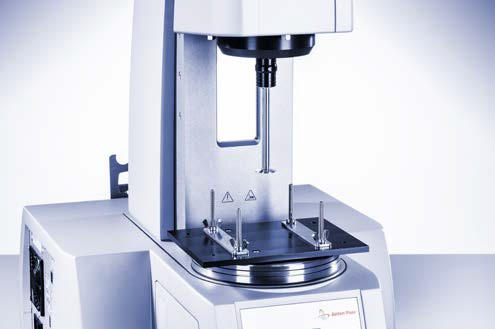Adhesion or tack describes the tendency of materials to form a connection to a substrate when contact pressure is applied for a short time. This property can be characterized with a Modular Compact Rheometer (MCR) from Anton Paar on both solid and liquid samples (solid tack, wet tack). Since the tack is not only dependent on the adhesive, but also on the substrate on which the adhesive is applied, a holder for mounting different plates on the MCR was developed.
Introduction
The tackiness of materials depends on various parameters, such as the cohesive forces of the adhesive itself, the adhesive forces between the substrate and the adhesive, the substrate, the dimensions of the bond and the aeration time before the substrates are brought together1,2.
Adhesion
Adhesion describes the tendency of two different materials to stick to each other. There is no single theory which describes all adhesive effects, but several mechanisms have been proposed so far. Such mechanisms are mechanical adhesion (interlock due to filled pores and voids), chemical adhesion (ionic, covalent or hydrogen bonds), dispersive adhesion (van der Waals forces), diffusive adhesion (usually takes place when bonding polymers) and electrostatic adhesion (the tack is created by a difference in the electrical charge at the joint).
Cohesion
Cohesion describes the tendency of two identical materials to stick to each other. The attraction forces are built by covalent, van der Waals and hydrogen bonds as well as entanglement of the material’s molecules.
Influence of the Substrate
Besides choosing the right adhesive, the substrate is mainly responsible for the tack and the behavior of the joint under load. On the one hand, the substrates’ chemical, physical and structural surface properties affect the interaction with the adhesive. On the other hand, the mechanical, physical and chemical properties of the substrates themselves influence the bond. For example, metallic materials basically won’t form chemical bonds with the adhesive, unlike polymers.
Influence of the Adhesive Layer Thickness
In principal, a bond’s stiffness will increase with decreasing thickness of the adhesive layer. This is due to different factors, such as prevention of transversal contraction, a higher ratio of interface stiffness to stiffness by cohesion as well as stresses by shrinkage and inhomogeneities at larger thicknesses.
Influence of the Aeration Time
When using solvent-based adhesives, the applied adhesive needs to air before the substrates’ surfaces can be brought together. Depending on the used solvent and adhesive, this period of time is an important factor for the resulting joint stiffness.

Figure 1. Tack test holder.

 Want to know more? Click here to read the full article.
Want to know more? Click here to read the full article.
.jpg)
This information has been sourced, reviewed and adapted from materials provided by Anton Paar GmbH.
For more information on this source, please visit Anton Paar GmbH.